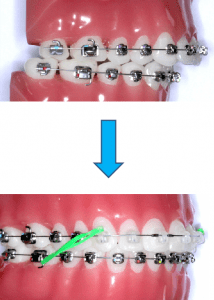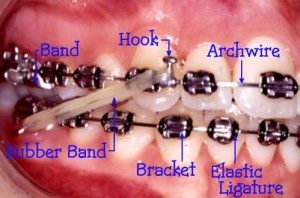There are two main types of orthodontic elastics: ligatures and inter-arch elastics (rubber bands). Ligatures are small elastics that are placed around each bracket and are used to hold the archwire in the slot on the bracket. They typically come in many different colors and can be used to push or pull teeth in a particular direction.
Rubber bands on the other hand are somewhat larger, also come in a variety of colors, but are used to apply pressure to the jaw to correct the alignment of your bite and reduce overbite/underbite. They can be applied in number of configurations, but the most common is inter-arch (from the top to the bottom).
Contents
What Do Rubber Bands (Elastics) Do?

While brackets, archwires and ligatures are responsible for moving teeth along the gumline and the angle at which they point away from the gums, rubber bands pull the jaw forward or backward in order to line up your top and bottom rows of teeth to improve your smile and make your teeth fit together comfortably when you bite down. They can also be used to speed up the process of moving or straightening a tooth or teeth.
To accomplish this, brackets with hooks are placed along the side of the mouth – one or more on both the left and right side of the top and bottom set of teeth (see below). A band is attached on each side of the mouth – from one hook/bracket to the other. The angle of the band depends on how much pressure needs to be applied to fix the over or underbite.
A typical patient in need of elastics is someone with an excessive overbite. When the overbite exceeds the acceptable measurement (2-3 millimeters or around 1-2 sixteenths of an inch), an orthodontist may decide to implement rubber bands.
There are two types of ligatures that an orthodontist may use. Single elastic ligatures apply force to the teeth at varying degrees. This depends on how the bands are tied onto the teeth.
The second type is connected elastic ligatures. These are used to close spaces between teeth or to move a specific group of teeth together in the same direction. Also known as a “power chain”, it is basically several ligatures connected in a row (picture below).
Both single and connected ligatures are available in different strengths and colors. The orthodontist will change ligatures during each follow-up visit.
How and When to Wear Them
Patients should follow directions carefully when wearing rubber bands for dental treatment. While the addition of rubber bands can cause significantly more pain, discomfort and inconvenience than just having the archwire and ligatures tightened once in a while, following the directions you are given will make sure treatment continues on schedule, provides optimal results and you will avoid prolonging the process.
In most cases, rubber bands must be worn 24 hours a day. Some dental professionals say that the only times you can take them out are to eat, floss or brush. Wearing elastics 100% is unrealistic in some cases as it is difficult for some people with certain elastic configurations to open their mouth wide enough to eat.
However, keeping the bands in while chewing can make the teeth to move faster and shorten treatment duration. It is also highly recommended that patients wear bands while sleeping.
Another important piece of advice for patients is to never double up on the elastics. While this might seem intuitive, it will not save time. In fact, a double application adds so much pressure that it slows down the movement of teeth and can damage their roots.

It is recommended that whenever bands are taken out, they should be discarded and replaced with brand new ones. Depending on the strength/thickness of the elastics and what your day-to-day activities are, you might have to replace them 3-4+ times every day so you should keep a pack of them on you at all times.
It is also advised to change them at least once a day. This is necessary even if they do not break since they tend to lose elasticity and strength over time. Instructions may vary slightly from patient to patient.
Orthodontic office staff provides patients with complete instructions on how to remove and replace the bands. Most patients figure out how to apply them quickly and easily without professional assistance after a few days of practice.
Soreness of the jaws, mouth and teeth is normal for the first few days after adding elastics to your treatment routine. However, wearing them intermittently can cause constant discomfort and slow the treatment’s rate of progress.
Available Colors and Combination Ideas
Dental elastics are typically available in a rainbow of color choices. Children and teenagers often try out a variety of patterns and combinations of bright colors. Most kids are excited to take full advantage of the broad range of color selections from which to choose.
They may want to pick colors based on holidays, school colors or even colors of their favorite sports team. Since bands are typically replaced during each follow-up visit, children can make frequent changes to their color selection. This lets kids have some fun while enduring the discomfort caused by braces.

Most adults may want rubber bands that are discrete, so they choose more conservative colors. These choices include clear or silver colored elastics. These colors are not susceptible to stains from certain beverages and foods and will not be mistaken for food particles or plaque.
Clear rubber bands are initially less noticeable than silver or gray bands. However, clear bands have a tendency to stain from drinking tea, wine or coffee. Sodas and dark colored foods may also cause discoloration of clear elastics.
If you are looking to buy rubber bands for braces online, please note that doing so is completely unnecessary in most cases (and it’s hard to find them anyway). If you require more elastics for whatever reason, ask your orthodontist for more and they will provide you with plenty more free of charge.